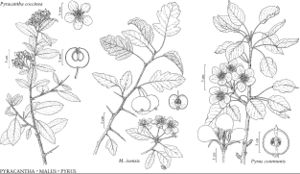Pyrus
Sp. Pl. 1: 479. 1753.
Gen. Pl. ed. 5, 214. 1754.
| Taxon | Illustrator ⠉ | |
|---|---|---|
 | Pyracantha coccinea Malus ioensis Pyrus communis | Marjorie C. Leggitt Marjorie C. Leggitt Marjorie C. Leggitt |
Trees, often pyramidal or oval in silhouette, (50–) 80–300 dm. Stems 1–many, erect; bark gray, reddish or orangebrown, smooth, older with gray or blackish rectangular plates; short-shoots sometimes present; thorns present or absent; young branches glabrous or tomentose; buds ovoid, narrowly ovoid, or triangular-ovoid, apex obtuse or acuminate, glabrous or sparsely to densely tomentose. Leaves deciduous, cauline, simple; stipules sometimes caducous, free, lanceolate, margins serrate or entire; petiole present; blade suborbiculate, ± ovate or ovatelanceolate to elliptic, oblong, or obovate, (2–) 5–9 (–12) cm, firm or leathery, margins flat, serrate, crenate, serrulate, crenulate, or entire, venation pinnate, surfaces hairy or glabrous. Inflorescences terminal on short branches, 4–9-flowered, racemes or simple corymbs, umbellike, with short persistent axis, glabrous or tomentose; bracts absent; bracteoles absent. Pedicels present. Flowers developing with or before leaves, perianth and androecium epigynous, 15–45 mm diam.; hypanthium campanulate or cupular, 3–5 mm diam., interior usually pubescent, exterior hairy or glabrous; sepals 5, reflexed, lanceolate or triangular-lanceolate to triangular or triangular-ovate; petals 5, white or creamy, ovate or ovate-elliptic to obovate or obovate-elliptic, base short-clawed, apex rounded; stamens 20, equal to or slightly shorter than petals; carpels 2–5, mostly connate, fully adnate to hypanthium, glabrous, styles terminal, distinct (constricted basally by hypanthium), ± equal to stamens; ovules 2. Fruits pomes, brown, red, green, or yellow, often dotted, globose, subglobose, ovoid, obovoid, or pyriform, 8–120 mm diam., glabrous; fleshy with abundant stone or grit cells; hypanthium persistent; sepals persistent or deciduous, reflexed; carpels cartilaginous; styles persistent or not. Seeds 2–5 (–10) per fruit. x = 34.
Distribution
Introduced; Europe, Asia, n Africa, also in Mexico, South America, Pacific Islands (New Zealand), Australia
Discussion
Species ca. 25 (6 in the flora).
Pyrus communis is widely cultivated and naturalized in temperate and subtropical regions around the world. The evergreen pear, P. kawakamii, is widely cultivated, especially in California. This taxon has recently been included in P. calleryana (G. Cuizhi and S. A. Spongberg 2003), which is escaped in California. Some of the ornamental pear cultivars available in North America are selections of the oriental P. betulifolia Bunge, with fruits less than 1 cm diameter and leaves tomentose or at least slightly hairy proximally. Pyrus betulifolia is frequently used as a grafting stock. The willow-leaved pear, P. salicifolia Pallas, with densely silvery-pubescent leaves, pendent branches, and brown, pyriform pomes, is rarely cultivated in North America and is not known to escape. The Ussurian pear, P. ussuriensis Maximowicz, is less often cultivated and not known in North America as an escape; it is distinguished by persistent sepals on the fruit and spinulose-serrate leaf margins.
Pyrus may be divided into three groups (J. S. Challice and M. N. Westwood 1973; R. L. Bell 1990; K. Browicz 1993). Pyrus calleryana belongs to the Asian pea pear group. Pyrus pyrifolia belongs to the medium- to large-fruited Asian pears. Both P. communis and P. nivalis belong to the group of European species.
Although the cultivated fruits of apples and pears are easily distinguished, the wild pears and wild apples are sometimes quite similar. Pears differ from apples (Malus) by their hard glossy leaves, leaf margins with callused serrations, flower clusters with a central axis, and fruit with abundant stone or grit cells. The closely related quince (Cydonia oblonga) differs in its basally subcordate leaves that are abaxially tomentose and have entire margins, and its tomentose, pyriform pomes.
The identification of wild pears in North America is difficult. For more information see 4. Pyrus calleryana. The genus requires more study to resolve relationships, taxa, and hybrid origins.
Selected References
None.
Lower Taxa
Key
| 1 | Branches white-tomentose when young; leaf blades: abaxial surfaces densely whitish gray pubescent. | Pyrus nivalis |
| 1 | Branches and leaf blades glabrous or glabrescent | > 2 |
| 2 | Leaf margins spinulose-serrate, surfaces brown-lanate when young; flowers 25–35 mm diam.; pomes subglobose. | Pyrus pyrifolia |
| 2 | Leaf margins entire or crenulate, serrulate, crenate-dentate, obtusely serrate, or crenate, surfaces glabrous or brown-tomentose abaxially when young; flowers 15–35 mm diam.; pomes globose, subglobose, obovoid, ovoid, or pyriform | > 3 |
| 3 | Styles 2 or 3(or 4); pomes blackish brown or dark brown, brown, or yellow-brown (often with pale dots), subglobose, globose, or obovoid, 10–15(–22) mm diam | > 4 |
| 3 | Styles 3(–5); pomes yellowish, green, brown, or red (with or without pale dots), globose, subglobose, ovoid, or pyriform, 8–160 × 8–120 mm | > 5 |
| 4 | Sepals mostly persistent; pomes subglobose or obovoid, 15–22 mm diam.; styles 3(or 4). | Pyrus serrulata |
| 4 | Sepals usually deciduous; pomes globose, 10–15 mm diam.; styles 2 or 3. | Pyrus calleryana |
| 5 | Leaf margins densely ciliate when young; sepals persistent; petals (12–)13–15 mm; leaf blades ovate or suborbiculate to elliptic, bases broadly cuneate to almost rounded. | Pyrus communis |
| 5 | Leaf margins eciliate or sparsely ciliate when young; sepals deciduous, sometimes persistent; petals 6–12 mm; leaf blades ovate, ovate-lanceolate, or suborbiculate, bases usually cordate, sometimes broadly rounded. | Pyrus cordata |
"thin" is not a number.